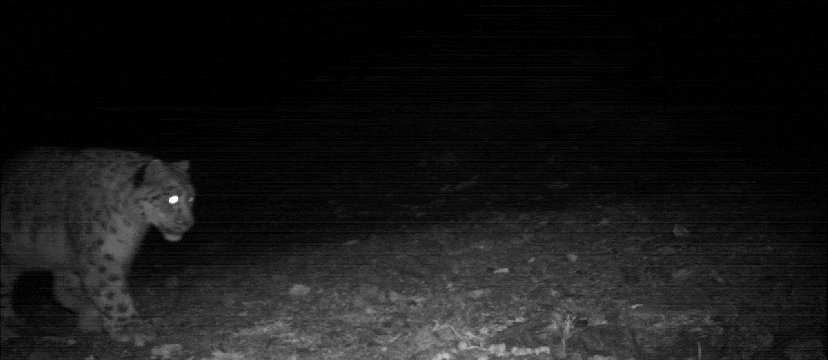A photo capture event is the set of images captured when an animal – snow leopard, fox, hedgehog or another species – moves in front of one of our research cameras and triggers it to take pictures. (Multiple pictures of the same animal taken during the same event are not considered separate photo captures.) We gathered these numbers over a three-year period in an area of the Southern Mongolian desert called the Small Gobi A Strictly Protect Area. The area has a variety of habitats with unique cliffs, sand dunes, barren lakes, and oases with streams. It is home to globally endangered snow leopard, as well as regionally threatened Goitered gazelle, ibex and argali.
Three years is a long time and any of these species might walk in front of our research cameras over this period, leading to thousands of images. This chart shows how many different photo captures of various species our cameras recorded during that time.
Each of these numbers tells a different story. Snow leopards are an elusive, low-density species. The fact that our cameras had 95 capture events of this endangered cat is amazing. We don’t know how many individual red fox or ibex this data represents. But because we can tell snow leopards apart by their unique coat patterns, we were able to analyze the images and determine that these 95 capture events represent nine adult snow leopards.
The Gobi desert stretches approximately 500,000 miles2, and of that, the Small Gobi A spans about 900 square miles. This survey was part of our long-term effort to understand snow leopard distribution and estimate the number of cats in the world.
The camera-trapping survey, done in close collaboration with the Small Gobi A Protected Area staff and local rangers, was conducted during the winter months (approx. November to March, 3-5 months at a time) for all three years. A total of 14-26 research cameras were set up annually near snow leopard scrapes along ridgelines, saddles and valleys to maximize the snow leopard camera capture rate.
Here’s a look at the nine different cats and a bit of information we gathered:
We could identify snow leopard individuals in 91% of the photo capture events. The remaining photos were not of high enough quality to identify the individual. Note that the nine adult snow leopards photographed do not necessarily equal the overall number of snow leopards in the area. There may have been a few individuals that were not captured on camera and some individuals may have immigrated or been lost during the three years.
It’s interesting to observe that five out of the nine snow leopards were photographed inside the Small Gobi A Strictly Protected Area, whereas the other four were photographed outside the protected area. Small Gobi A is important for snow leopard distribution, possibly linking snow leopard populations between Mongolia and the Inner Mongolia Province of China.
Our research provides critical information on snow leopards, prey and human-wildlife interactions that directly supports the conservation of this threatened species in the South Gobi and globally.
Thank you to the Small Gobi-A Strictly Protected Area Management team and Director Ch. Batsukh.












You are AMAZING! Thank you for the fantástic work! I’m Portugueses, I would like to help all you are going! Thank you very much.
Brings happy tears to see these beauties’. I will always donate where I can. Best gift o give my family and friends is to adopt in their name instead of useless items they usually do not need or want.
Thanks to you all for you passion to help.
N
Thank you for sharing. These are one of the most versatile, beautiful, unbelievable cats on earth. This is God’s cat.
Thank you for the important work you do and for sharing some of it with the public!
Such beautiful images of these magnificent cats. No words can express the depth of my gratefulness for all your selfless actions in protecting these cats and for educating those who live amongst them. It’s always the wild animals who are blamed and sometimes killed all for the fact that it’s just doing what comes naturally to hunt to survive! But, with all that you folks do to create a middle balance, I thank you for caring.